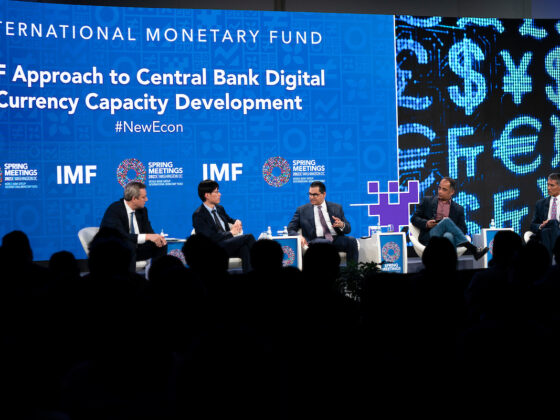In Part 1 we noted that “money” is no more than a medium of exchange. If we cooperate in sufficient numbers, we could create an economy based upon an entirely voluntary monetary system. We don’t need banks to control our exchange transactions and modern Distributed Ledger Technology (DLT) has made voluntary exchange on a global scale entirely feasible.
We contrasted the true nature of “money” with the proposed Central Bank Digital Currencies. CBDC is being rolled out across the world by a global public-private partnership . What we call money is actually fiat currency conjured out of thin air by central and commercial banks. Even so, CBDC is nothing like “money” as we currently understand it.
Prior to the pseudopandemic, fiat currency circulated in a split-monetary circuit. Only commercial banks could access a type of money called “central bank reserves” or “base money.” In late 2019, the global financial institution BlackRock introduced a monetary plan that advocated “going direct” in order “to get central bank money directly in the hands of public and private sector spenders.”
We discussed how the idea of putting “central bank money” directly into the hands of “private sector spenders” is precisely what that new CBDC based International Monetary and Financial System (IMFS) is designed to achieve. But CBDC will accomplish far more for the global parasite class than merely revamp its failing “debt” based IMFS.
If it is universally adopted, CBDC will afford the bankers complete control over the our daily lives. The surveillance grid will be omnipresent and every aspect of our lives will be engineered.
CBDC is the endgame and, in this article, we will explore how that game will play out.
If we allow it.
The Interoperable CBDC Empire
The BIS does not come under the jurisdiction of any nation state nor intergovernmental organisation. It is exempt from all “law” and is arguably sovereign over the entire planet. As its current monetary system power-base declines, it is rolling out CBDC to protect and enhance its own authority.
While a “most likely” CBDC “platform” model has emerged, there is, as yet, no agreed single technical specification for CBDC. But, for the reasons we discussed previously, it is safe to say that no national model will be based upon a permissionless DLT—blockchain or otherwise—and all of them will be “interoperable.”
In 2021 the BIS published its Central bank digital currencies for cross-border payments report. The BIS defined “interoperability” as:
The technical or legal compatibility that enables a system or mechanism to be used in conjunction with other systems or mechanisms. Interoperability allows participants in different systems to conduct, clear and settle payments or financial transactions across systems
The BIS’ global debt based monetary system is “tapped out” and CBDC is the central bankers’ solution. Their intended technocratic empire is global. Consequently, all national CBDCs will be “interoperable.” Alleged geopolitical tensions are irrelevant.
The CBDC Tracker from the NATO think tank, the Atlantic Council, currently reports that 114 countries, representing 95% of global GDP, are actively developing their CBDC. Of these, 11 have already launched.
Just as the pseudopandemic initiated the process of getting “central bank money” directly into private hands so, according to the Atlantic Council, the sanction response to the war in Ukraine has added further impetus to the development of CBDC:
Financial sanctions on Russia have led countries to consider payment systems that avoid the dollar. There are now 9 cross-border wholesale CBDC tests and 7 cross-border retail projects, nearly double the number from 2021.
That this evidences the global coordination of a worldwide CBDC project, and that the BIS innovation hubs have been established to coordinate it, is apparently some sort of secret. China’s PBC, for example, is a shining beacon of CBDC light as far as the BIS are concerned:
[. . . ] improving cross-border payments efficiency is also an important motivation for CBDC work. [. . .] The possibilities for cross-border use of retail CBDC are exemplified by the approaches in the advanced CBDC project in China[.]
The People’s Bank of China (PBC) has been coordinating development of its CBDC cross-border payment system in partnership with the BIS via the m-Bridge CBDC project which is overseen by the BIS’ Hong Kong innovation hub.
Supposedly, the Central Bank of the Russian Federation (CBR – Bank of Russia) was suspended by the BIS. Apparently, it was also ousted from the SWIFT telecommunications system. We were told that this was a “punishement” for the Russian government’s escelation of the war in Ukraine. In reality, it is doubtful that the BIS suspension ever occurred, and the SWIFT sanction was a meaningless gesture. Developing interoperable CBDC’s takes precedence over anything else.
All we have to substantiate the BIS suspension claim is some Western media reports, citing anonymous BIS sources, and an ambiguous footnote on a couple of BIS documents. Meanwhile, the CBR is currently listed as an active BIS member with full voting rights and no one, either from the BIS or the CBR, has made any official statement in regard to the supposed suspension.
The CBR’s cross-border CBDC development uses two of the three BIS m-Bridge CBDC models and it is testing its interoperable “digital ruble” with the PBC. Seeing as the PBC is BIS m-Bridge development “partner,” alleged suspension or not, there is no chance that the “digital ruble” won’t be interoperable with the BIS’ new global financial system.
The Society for Worldwide Interbank Financial Telecommunication (SWIFT) provides the world’s most pervasive encoded inter-bank messaging system. Both central and commercial banks, as well as other private financial institutions, use SWIFT to securely transmit transaction data.
There are a number of SWIFT alternatives. For example, the CBR developed its parallel System for Transfer of Financial Messages (SPFS) in 2014 which went live in 2017. Numerous Russian banks were already using the PBC’s China International Payments System (CIPS) long before any supposed censure by SWIFT.
CIPS was developed by the PBC in partnership with SWIFT. As a result of SWIFT’s “sanction” of the CBR, the PBC and the CBR then started collaborating in earnest on a potential CIPS based SWIFT replacement. If the stories we are told are true, SWIFT’s action appears to have been an empty act of self-defeating folly.
None of the various communication layer technologies are financial systems in and of themselves, but they enable banks, trading platforms, clearing houses, payment processing systems and all the other elements of the global financial system to communicate with each other. For CBDCs to be successful they need to be interoperable both with these systems and with each other.
Interoperability also extends to existing fiat currencies and other financial assets, such as mortgage backed securities and exchange traded funds (ETFs). These assets, funds, currencies and securities, etc. can be “tokenised.” As can practically any physical or virtual asset or commodity.
Hidera, a distributed ledger technology company that uses the hashgraph based DLT—a blockchain alternative—is backed by a number of wealthy global corporations. The company explains the asset tokenisation (or tokenization) process:
Asset tokenization is the process by which an issuer creates digital tokens on a distributed ledger or blockchain, which represent either digital or physical assets. [. . .] Suppose you have a property worth $500,000 in New York, NY. Asset tokenization could convert ownership of this property into 500,000 tokens — each one representing a tiny percentage (0.0002%) of the property. [. . .] The possibilities are endless as tokenization allows for both fractional ownership and proof-of-ownership. From traditional assets like venture capital funds, bonds, commodities, and real-estate properties to exotic assets like sports teams, race horses, artwork, and celebrities, companies worldwide use blockchain technology to tokenize almost anything.
The ability to trade tokenised assets internationally in any market, using CBDC, will facilitate the creation of a new CBDC based IMFS. Furthermore, digital “tokenisation” means anything can be converted into a financial asset and then traded on the new, CBDC based, digital IMFS.
For example, the BIS’ Project Genesis tokenised “government green bonds.” The World Bank explains “green bonds”:
A bond is a form of debt security. A debt security is a legal contract for money owed that can be bought and sold between parties. [. . .] A green bond is a debt security that is issued to raise capital specifically to support climate related or environmental projects.
Using CBDC’s added “smart contract” functionality, Project Genesis appended “mitigation outcome interests” smart contracts (MOIs) to their green bond purchase agreements. When the bond matured, in addition to any premium or coupon payments from the bond itself, the investor received verified carbon credits. The carbon credits are also tradable assets and they too can be tokenised.
Tokenised assets, traded using the CBDCs that central banks create from nothing, will generate almost limitless permutations for the formation of new markets. Subsequent profits will soar.
This “financialisation of everything” will further remove an already distant financial system to from the real, productive economy the rest of us live in. Needless to say, “interoperability” is a key desired “feature” of CBDC.
The BIS published its Project Helvetia report in December 2020 which demonstrated proof of concept for the settlement payment for “tokenised assets” using CBDC. SWIFT subsequently published the findings from its Connecting Digital Islands: CBDCs modelling experiment in October 2022.
SWIFT’s stated objective was to link various national CBDCs to existing payment systems and thereby achieve “global interoperability.” SWIFT was delighted to report:
These new experiments have successfully demonstrated a groundbreaking solution capable of interlinking CBDC networks and existing payments systems for cross-border transactions. Interlinking is a solution to achieve interoperability [.] [. . .] This solution can provide CBDC network operators at central banks with simple enablement and integration of domestic CBDC networks into cross-border payments [.]
In its associated press release, SWIFT announced:
Swift has successfully shown that Central Bank Digital Currencies (CBDCs) and tokenised assets can move seamlessly on existing financial infrastructure – a major milestone towards enabling their smooth integration into the international financial ecosystem.
Whatever CBDC design national central banks adopt, no matter which inter-bank payment system they access—be it SWIFT, CIPS or some new communication layer—global interoperability is assured. Thus many different CBDCs can form one, centrally controlled IMFS that will transact in near instantaneous real time.
Control of this CBDC system will also mean the centralised global power to limit or block payments, target users, redirect funds, enforce purchases, trade assets, add contracts, tax at source and generally exploit any of the other endless range of “functions” CBDC is capable of. In near instantaneous real time.

The CBDC Flimflam
There is scope for innovation to generate further efficiencies in payments, allowing for faster and/or cheaper payments. [. . .] The digital pound could also complement existing financial inclusion initiatives, for example if it were able to provide for offline payments.
In its 2021 document on the Digital Ruble Concept, the CBR said that it had developed its Russian CBDC in response to:
[. . .] growing demand from households and businesses to improve the speed, convenience and safety of payments and transfers, as well as for cost reduction in the financial sphere.
The claimed advantages of cost saving, efficiency, speed , convenience, financial inclusion, improved resilience, financial security and so on, are trotted out time and time again. All of it is part of a dangerous and completely disingenuous sales pitch deceiving you into accepting your own monetary slavery.
Further on, the CBR reveals what has really spurred its development of the “digital ruble:”
[. . .] smart contracts may also be used to mark digital rubles, which will allow setting conditions for spending digital rubles (e.g. defining specific categories of goods/services that can be purchased with them) and tracing the entire chain of movement of the marked digital rubles. [. . .] Digital ruble settlements do not provide for the anonymity of payments.
The digital ruble might initially seem more “convenient” but it is also designed to enable the the Russian central bankers to identify exactly who is buying what, anywhere in the country at any time. It will also empower them to set the “contract” conditions which will determine what Russians can buy, when and from whom. The central bankers will decide what “choices” Russian CBDC users are allowed to make.
We should not be duped by the faux rationales offered by the proponents of CBDC. Despite all the cosy rhetoric from the likes of the CBR and the BoE, the real objective is to enhance the global power and authority of bankers. As far as they are concerned, this power will know no bounds.
For instance, the BoE’s Jon Cunliffe added:
[. . .] there are broader macro-economic and geopolitical issues that need to be considered. The Bank of England is working actively on these issues with international counterparts through the Bank for International Settlements Committee on Payments and Market Infrastructures (CPMI), through the G7, the G20 and FSB [Financial Stability Board] and through close cooperation with a small group of advanced economy central banks.
Don’t be surprised that the central bankers consider geopolitics to be within their remit. Their stated intention to “actively” work on geopolitical “issues” has no “democratic” mandate whatsoever, but so what? They don’t care, why should they? Who is paying attention? Most of us are too busy worrying about feeding ourselves and paying our energy bills.
The fact that bankers have long been able exert inordinate influence over geopolitics, economics and society has always been to our detriment. If we continue to neglect our duty to defend each other and ourselves, and if we blindly accept CBDC, the bankers’ power and authority will be immeasurable.
In 2020, the Russian Federation government amended its legal code with the “Law on Digital Financial Assets” (DFAs). The amendment regulated “non-cash ruble” DFAs. The CBR soon added its commercial bank partner Sberbank to the list of financial institutions authorised by the CBR to issue DFAs. In December 2022 Sberbank launched its “gold backed ” DFA offering “tokenised” gold.
Since 1971, when central banks finally abandoned any semblance of gold standard, many have lamented the supposed loss of fiat currency’s “intrinsic value.” The possibility of adding “intrinsic value” to CBDC through smart contracts is apparently enticing some to now welcome CBDC and, thereby, their own enslavement.
The Russian and Iranian governments have already proposed a possible gold-backed CBDC “stablecoin” for interoperable cross border payments. “Interoperability” suggests it could be “backed” by Sberbank’s tokenised gold DFA.
If this sounds suspiciously like a shell game that’s because it is. Nonetheless, some are convinced and have extolled the alleged virtues of this “gold backed” CBDC.
It makes no difference if CBDC is backed by gold, oil, nuclear weapons or unicorn horns. All claims of its advantages are nothing but CBDC flimflam.
No matter how it is spun, the brutal fact is that CBDC affords an unimaginable degree of social control to those who program it. From our perspective, unless we have completely taken leave of our senses, nothing warrants taking that risk.

The Programmable CBDC Nightmare
The BoE is among the central banks to reassure the public that it won’t “implement central bank-initiated programmable functions.” Elsewhere, it also claims that is a public institution, which isn’t true. So we have little reason to believe anything the BoE says.
Not that it matters much, because the BoE assurances given in its CBDC technical specification don’t provide reason for optimism:
Central bank-initiated programmable use cases are not currently relevant to the Bank and HM Treasury’s policy objectives for CBDC.
Perhaps “not currently” but enforcing programmable CBDC may well become “relevant,” don’t you think? Especially given that the BoE adds:
The design of a UK CBDC must deliver the Government and Bank’s [the BoE] policy objectives. [. . .] Over the longer term, innovation and evolving user needs may mean a broader range of CBDC payment types could be offered. For example, offline and cross-border payments could support public policy objectives.
As if this mealymouthed squeamishness wasn’t bad enough, the BoE then goes on to suggest we should welcome their dream of a stakeholder-capitalism CBDC Wild West:
[T]he Bank [BoE] would aim to support programmable functionality[.] [. . .] These functionalities would be implemented by PIPs [Payment Interface Providers] and ESIPs [External Service Interface Providers], and would require user consent. PIPs could implement some of these features, such as automated payments and programmable wallets, by hosting the programmable logic [. . .]. But other features [. . .] might require additional design considerations. [. . .] [T]he Bank would only provide the necessary infrastructure to support PIPs and ESIPs to provide these functionalities. [. . .] An automated payment could be particularly useful in IoT [Internet of Things] use cases. [. . .] PIPs could host their own logic that triggers a payment.
If the BoE don’t “currently” feel the need to program your “money,” how about handing program control over to HSBC, Barclays, Mastercard or PayPal? They will program your CBDC to “deliver the Government and Bank’s [the BoE] policy objectives.” Undoubtedly adding some lucrative “contract logic” of their own along the way. What could possibly go wrong?
Let’s say EDF Energy is your energy provider. You could let BlackRock, working in partnership with the manufacturers it invests in, exploit the IoT to program your washing machine to automatically pay for your energy use by deducting your “money” from your CBDC “wallet”, subject to whatever “contract logic” BlackRock has agreed with EDF Energy.
If you run a small UK business you could let your bank automatically deduct income tax from your earnings and pay it directly to the Treasury. No need for the inconvenience of self-assessment. CBDC will be so much more “convenient.”
Of course, this will be entirely “optional,” although it may be a condition of opening a business account with your bank. In which case your CBDC “option” will be to work in a central bank managed CBDC run business or don’t engage in any business at all.
How does that all sound to you? Because that is exactly the “model” of retail CBDC that the BoE are proposing. So are nearly all other central banks because CBDC is being rolled out, for all intents and purposes, simultaneously on a global scale.
The Retail CBDC Nightmare
The BoE claims that retail CBDC is essential to maintain access to central bank money. This is only “essential” for bankers, not us.
It also alleges that its digital pound model has been offered to the public merely for “consultation” purposes. Yet it has only offered one, very specific CBDC design for our consideration and the “consultation” deploys the Delphi technique to ensure that responses are limited to expressing levels of agreement with the imposed, underlying premise. The only question appears to be when we will adopt CBDC, not if.
The usual flimflam, talking about inclusion, cost savings, offering choice and yada yada, peppers the BoE’s statements and documents. The BoE also lays out its retail CBDC panopticon.
The UK’s CBDC won’t initially target everyone. Speaking about the design of the digital pound, Jon Cunliffe said:
We propose a limit of between £10,000 and £20,000 per individual as the appropriate balance between managing risks and supporting wide usability of the digital pound. A limit of £10,000 would mean that three quarters of people could receive their pay in digital pounds, while a £20,000 limit would allow almost everyone to receive their pay in digital pounds.
If working people are “paid” in CBDC they won’t actually have any “choice” at all. The low paid and those reliant upon benefits payments will have no option but to use CBDC. The independently wealthy, for whom £20,000 is neither here nor there, won’t.
Cunliffe’s comments highlight the possibility that savings can also be limited in the brave new CBDC world. He clearly suggests that those on low incomes won’t be able to hold more than CBDC-£20,000 and will perhaps be limited to as little as CBDC-£10,000.
Unsurprisingly, the UK’s CBDC won’t be based upon a permissionless DLT that could potentially grant anonymity, but rather upon, what the BoE calls, its “platform model.” The BoE will “host” the “core ledger” and the application layer (API) will allow the BoE’s carefully selected private sector partners—called Payment Interface Providers (PIPs) and External Service Interface Providers (ESIPs)—to act as the payment gateways.
The PIPs and the ESIPs will be “regulated,” and will thus be empowered on a preferential basis by the central bank. If CBDC becomes the dominant monetary system, as is clearly the intention, by controlling “access to the ledger,” all user transactions—our everyday activity—will be under the thumb of a public private-partnership led, in the UK, by the BoE.
While the majority of British people don’t have anywhere near £10,000 in savings, the ability to control the amount we can save, and the rate at which we spend, is a tantalising prospect for the central bankers. Add in the ability to specify what we can spend it on and it’s their dream ticket.
The BoE wishes to impose the most oppressive form of retail CBDC possible, but they aren’t alone. The Russian CBR’s model is another, among many others, that is just as tyrannical. The Russian’s CBDC is also constructed upon a “platform” model that is uncannily similar to the UK’s.
Just like British citizens, Russian’s behaviour will be monitored and controlled by their private central bank and its partners through their CBDC “wallets.” The CBR’s “Model D” CBDC is also a “a retail two-tier model with financial institutions [private corporate partners] as settlement participants.”
The CBR states:
Digital rubles are unique digital codes (tokens) held in clients’ electronic wallets on the digital ruble platform. [. . .] The Bank of Russia opens wallets for financial institutions and the Federal Treasury while financial institutions open wallets for clients [businesses and individuals] on the digital ruble platform. Only one digital ruble wallet is opened for a client.
Every Russian business and private citizen will each have one CBDC wallet allocated to them by the CBR. Russian commercial banks will enable the “client onboarding” to speed up adoption of CBDC. The commercial banks and other “financial institutions” will then process CBDC payments and act as payment intermediaries on the CBR’s Model D “platform.”
The People’s Bank of China (PBoC) and the Reserve Bank of India (RBI) are among those considering programming expiration dates into their CBDC’s. This will ensure that Chinese and Indian CBDC users can’t save and have to spend their issued “money” before it expires and ceases to function. Thereby “stimulating” economic activity in the most “going direct” way imaginable.
The BoE proposes exactly the same in its model of digital pound. The BoE is reluctant to concede that its CBDC will be used to enforce policy. Instead, it has devolved this power to its commercial banks “partners” which the BoE will then control through regulation:
A range of programmable features might be enabled by providing API access to locking mechanisms on the core ledger. [. . .] This enables PIPs and ESIPs to facilitate more complex programmable functionality off ledger. [. . .] The funds would be locked until a pre-defined condition has been met. [. . .] The PIPs and ESIPs would host contract logic on their own infrastructure, but would instruct the release of funds via API to the core ledger. [. . .] If the set conditions are not met, all locks would have an expiry time where the funds are released back to the original owner.
The BoE public-private partnership could, for example, program its CBDC with an expiry date. The PIPs or the ESIPs could then modify the program adding “more complex” conditions through their own “contract logic” infrastructure. For example, the BoE could specify that the CBDC your “wallet” will expire by next Wednesday.
A PIP or ESIP could add some contract logic to ensure you can only buy Italian coffee—before next Wednesday. This could be enforced at the point of sale in any retail setting (off ledger).
This is a silly example, but don’t be fooled into believing such an excruciating degree of oppressive control isn’t possible. Programmable CBDC, probably programmed by AI algorithms, is capable of enforcing an intricate web of strictures over our everyday lives.
Just as you can send an encrypted message to anyone else on the same message app, so CBDC “smart contracts” can be tailored to the precisely prescribe what you can or cannot do with your “money.”

They Wouldn’t Do That Though Would They?
The infamous quote, from a salivating BIS general manager Agustín Carstens, reveals why central bankers are so excited about CBDC:
We don’t know who’s using a $100 bill today and we don’t know who’s using a 1,000 peso bill today. The key difference with the CBDC is the central bank will have absolute control on the rules and regulations that will determine the use of that expression of central bank liability, and also we will have the technology to enforce that.
We can look to other influential central bankers to appreciate what kind of “rules” central banks might choose to “enforce” by exercising their “absolute control.”
Bo Li, the former Deputy Governor of the Bank of China and the current Deputy Managing Director of the International Monetary Fund (IMF), speaking at the Central Bank Digital Currencies for Financial Inclusion: Risks and Rewards symposium, offered further clarification
CBDC can allow government agencies and private sector players to program [CBDC] to create smart-contracts, to allow targetted policy functions. For example[,] welfare payments [. . .], consumptions coupons, [. . .] food stamps. By programming, CBDC money can be precisely targeted [to] what kind of [things] people can own, and what kind of use [for which] this money can be utilised. For example, [. . .] for food.
Nigeria has already launched its eNaira retail CBDC. The Nigerian central bank and the BIS have immediately used it as a tool to roll out Digital ID:
Universal access to eNaira is a key goal of the CBN [Central Bank of Nigeria], and new forms of digital identification are being issued to the unbanked to help with access. [. . .] When it comes to anonymity, the CBN has opted to not allow anonymity even for lower-tier wallets. At present, a bank verification number is required to open a retail customer wallet.
The French central bank—the Banque de France—hosted a conference in September 2022 where US and EU central bankers decided that their retail CBDC would also force Digital ID upon users. Indeed, all central banks have effectively “ruled out” any possibility of “anonymous use” of their programmable money.
The Reserve Bank of India states:
Most central banks and other observers have, however, noted that the potential for anonymous digital currency to facilitate shadow-economy and illegal transactions, makes it highly unlikely that any CBDC would be designed to fully match the levels of anonymity and privacy currently available with physical cash.
Once we have no option but to use CBDC nor will we have any but to accept Digital ID. We will be fully visible on the grid at all times.
Currently if the state wishes to lockdown its citizens or limit their movement within 15 minutes of their homes they need some form of legislation or enforceable regulation. Once we start using CBDC that is linked to our Digital ID, complete with biometric, address and other details, they won’t need legislation or regulation.
They can simply switch off your “money,” making it impossible to use outside of your restriction zone. Potentially limiting you to online purchases made only from your registered IP address. CBDC will ensure your compliance.
It is no use imagining that “they wouldn’t do that.” We have already seen the use of monetary punishment and control in our so-called liberal democracies. Numerous private payment providers removed access from those who, in their view, expressed to wrong opinion.
When Canadians exercised their legitimate right to peaceful protest and their fellow Canadians chose to offer their financial support to the protesters, the commercial banks worked in partnership with the Canadian state to freeze protesters accounts and shut down their funding streams.
CBDC will make this a matter of routine, as targeted individuals are punished for their dissent or disobedience. It stretches naivety to wilful ignorance to believe that it won’t.
The whole point of CBDC is to control the herd and enhance the power and authority of the parasite class. CBDC is a social engineering tool designed to establish a prison planet. Unless you want to be a slave, there is no possible justification for using CBDC. Submitting to CBDC enslavement truly is a “choice.”
Please share these articles. It is absolutely vital that as many people as possible understand the true nature of CBDC. We cannot rely upon the state or the mainstream media for anything approaching transparency or honesty on the subject. With regard to our potentially calamitous adoption of CBDC, they are the enemy.
Fortunately, if we decide to resist there is no reason why we have to succumb to using CBDC. In order to construct better systems of exchange that will render CBDC superfluous, we have to come together in our communities. It won’t be easy, there are no simple solutions nor one “perfect” strategic response.
But the fact is, we simply cannot afford CBDC.














